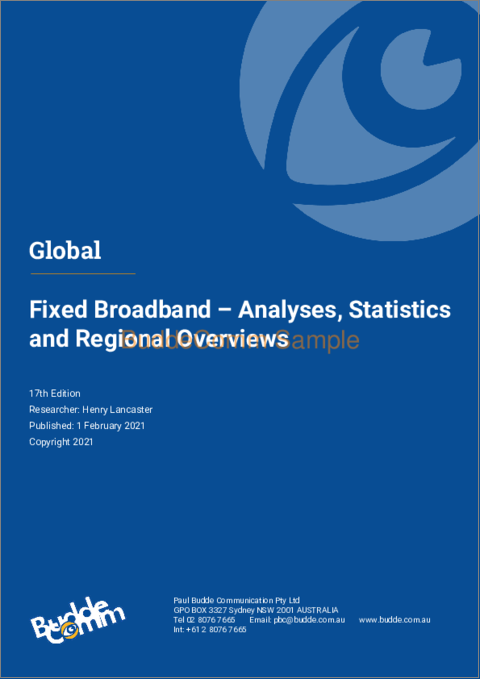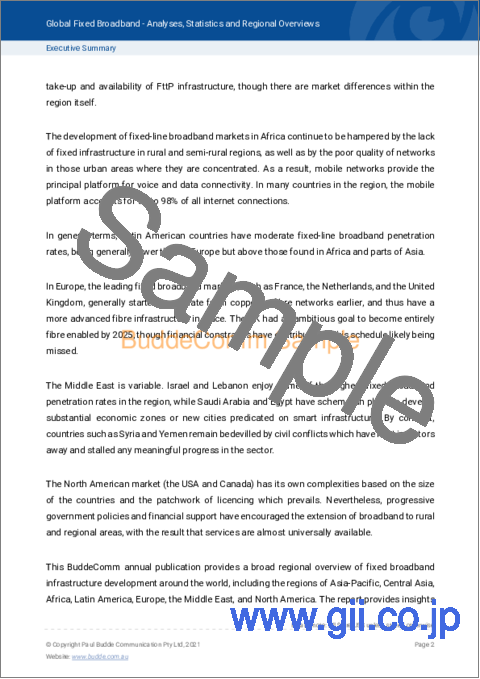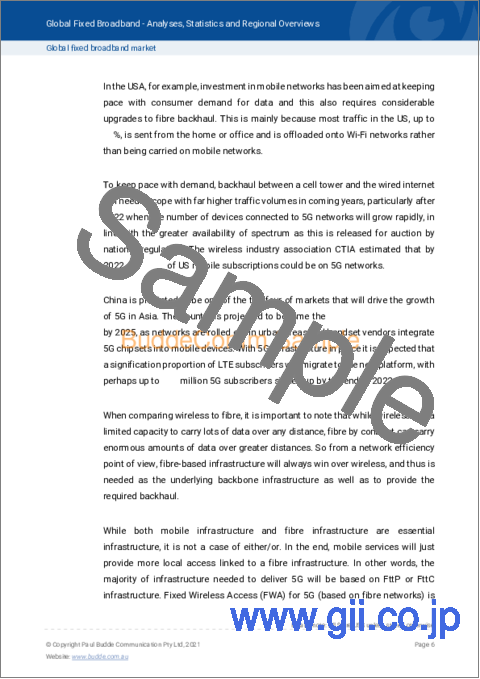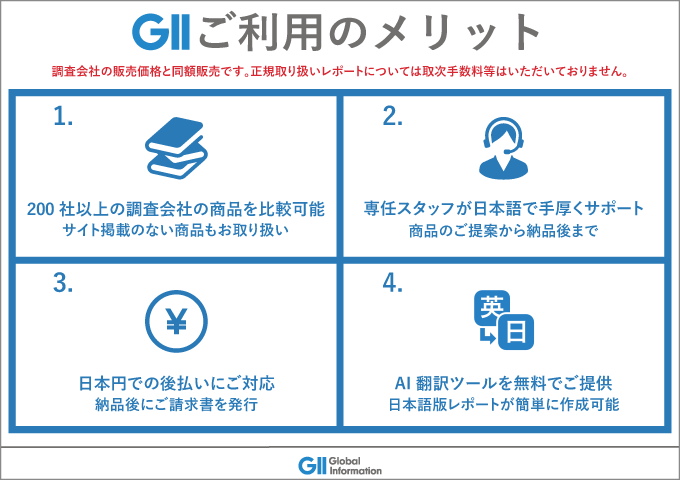|
|
市場調査レポート
商品コード
991699
固定ブロードバンドの世界市場 - 分析・統計・地域別の概要Global Fixed Broadband - Analyses, Statistics and Regional Overviews |
||||||
| 固定ブロードバンドの世界市場 - 分析・統計・地域別の概要 |
|
出版日: 2023年01月01日
発行: BuddeComm
ページ情報: 英文 64 Pages
納期: 3~5営業日
|
- 全表示
- 概要
- 図表
- 目次
この20年間、政府や各国の通信規制当局は、経済成長が有能なブロードバンドインフラによって支えられていることを確認するために多大な努力を払ってきました。進行中のパンデミックはまた、通信インフラが堅牢であることを保証する必要性に通信事業者の注意を集中させましたが、固定回線ブロードバンドは在宅勤務と自宅学習に不可欠なサービスになりました。多くの市場で、サブスクリプション数が大幅に増加しました。電子決済など、デジタル経済における関連サービスの使用もサポートされています。
当レポートでは、世界の固定ブロードバンドインフラ開発における地域別の概要について提供し、各市場への考察と分析について、体系的な情報を提供しています。
目次
世界の固定ブロードバンド市場
- ファイバーブロードバンドは5Gに必要
- 5G 固定無線アクセス(FWA)
- 世界の固定ブロードバンド加入者数
- 世界の海底ケーブルの概要
- 新興経済諸国にフォーカス
アジア太平洋地域
- アジア
- オーストラリア
- 南太平洋
中央アジア
アフリカ
ラテンアメリカ
- ラテンアメリカの概要
- カリブ海諸国の概要
欧州
中東
- 中東におけるFttP
北米
- 米国
- 米国の固定ブロードバンド市場分析
- 米国の固定ブロードバンド市場統計
- カナダ
- カナダの固定ブロードバンド市場概要
- カナダの固定ブロードバンド市場分析
List of Tables
- Table 1 - Global - Change in the number of fixed broadband subscribers - 2010 - 2021
- Table 2 - Asia - fixed broadband subscribers and penetration - 2012 - 2025
- Table 3 - Asian countries - fixed broadband subscribers - 2012 - 2019
- Table 4 - Asian countries - fixed broadband penetration - 2012 - 2019
- Table 5 - Australia - fixed and wireless broadband subscribers - 2015 - 2020
- Table 6 - South Pacific - fixed broadband subscriptions by largest countries - 2019 - 2020
- Table 7 - Central Asia - fixed broadband subscribers - 2015 - 2021
- Table 8 - Africa - Fixed broadband subscribers and penetration - 2014 - 2019
- Table 9 - Select African countries - Fixed broadband subscribers - 2018 - 2021
- Table 10 - Select African countries - Fixed broadband penetration (%) - 2018 - 2021
- Table 11 - Latin America - fixed broadband subscribers - 2019 - 2020
- Table 12 - Europe - fixed broadband subscribers, select countries - 2019 - 2020
- Table 13 - Middle East - Fixed broadband subscribers - 2019 - 2020
- Table 14 - FttH/B in the MENA region - subscribers and homes passed - 2014 - 2019
- Table 15 - USA - growth in the number of fixed broadband subscribers and penetration - 2010 - 2025
- Table 16 - Canada - growth in the number of fixed broadband subscribers and penetration - 2010 - 2025
List of Charts
- Chart 1 - Asia - fixed broadband subscribers and penetration - 2012 - 2025
- Chart 2 - North Africa fixed and mobile broadband penetration rates
- Chart 3 - West Africa fixed and mobile broadband penetration rates
- Chart 4 - Southern Africa fixed and mobile broadband penetration rates
- Chart 5 - Central Africa fixed and mobile broadband penetration rates
- Chart 6 - East Africa fixed and mobile broadband penetration rates
- Chart 7 - Latin America fixed broadband penetration versus mobile broadband penetration
- Chart 8 - Caribbean fixed broadband penetration versus mobile broadband penetration
- Chart 9 - Scandinavia and Baltics - fixed and mobile broadband penetration
- Chart 10 - Northern Europe - fixed and mobile broadband penetration
- Chart 11 - Southern Europe - fixed and mobile broadband penetration
- Chart 12 - Eastern Europe - fixed and mobile broadband penetration
- Chart 13 - USA - growth in the number of fixed broadband subscribers and penetration - 2010 - 2025
- Chart 14 - Canada - growth in the number of fixed broadband subscribers and penetration - 2010 - 2025
List of Exhibits
- Exhibit 1 - Fixed broadband networks are important for society
- Exhibit 2 - 2Africa submarine cable
- Exhibit 3 - 2Africa landing stations
Fixed broadband development becomes important for 5G globally
During the past two decades there have been considerable efforts undertaken by governments and national telecom regulators to ensure that their countries' economic growth is underpinned by capable broadband infrastructure. The success of national policies has been variable, but the scale of investment and the manner in which the development of fibre infrastructure has been encouraged has been significant during the last five years or so.
The ongoing pandemic has also focused the attention of telcos on the need to ensure that telecom infrastructure is robust, while in the popular imagination fixed-line broadband has become an essential service for home working and home schooling. The increasing dependence on home internet services has led to significant growth in the number of subscriptions in many markets. It has also supported the use of associated services within the digital economy, such as e-payments.
Improved fibre-based broadband has also expedited the fall in the number of DSL connections in some regions, notably Europe and North America, as customers are migrated to fibre. The cable broadband sector has proved more resilient as customers are able to take advantage of cablecos' investment in DOCSIS3.1 technology.
In addition, fibre-based infrastructure is supporting the complex requirements for the transition to smart telecoms, incorporating smart grids and smart cities. It is also evident that such infrastructure is pivotal in forming the backbone for 5G infrastructure.
From a global perspective, the various regions and countries can vary markedly in terms of fixed broadband development. Overall, Asia continues to be a leading region, not only in the roll-out of broadband infrastructure, but also in promoting and applying the increased use of broadband to facilitate digital economies. Asia also continues to be the dominant region globally in the take-up and availability of FttP infrastructure, though there are market differences within the region itself.
The development of fixed-line broadband markets in Africa continue to be hampered by the lack of fixed infrastructure in rural and semi-rural regions, as well as by the poor quality of networks in those urban areas where they are concentrated. As a result, mobile networks provide the principal platform for voice and data connectivity. In many countries in the region, the mobile platform accounts for up to 98% of all internet connections.
In general terms, Latin American countries have moderate fixed-line broadband penetration rates, being generally lower than in Europe but above those found in Africa and parts of Asia.
In Europe, the leading fixed broadband markets, such as France, the Netherlands, and the United Kingdom, generally started to migrate from copper to fibre networks earlier, and thus have a more advanced fibre infrastructure in place. The UK had an ambitious goal to become entirely fibre enabled by 2025, though financial constraints have contributed to this schedule likely being missed.
The Middle East is variable. Israel and Lebanon enjoy some of the highest fixed broadband penetration rates in the region, while Saudi Arabia and Egypt have schemes in place to develop substantial economic zones or new cities predicated on smart infrastructure. By contrast, countries such as Syria and Yemen remain bedevilled by civil conflicts which have kept investors away and stalled any meaningful progress in the sector.
The North American market (the USA and Canada) has its own complexities based on the size of the countries and the patchwork of licencing which prevails. Nevertheless, progressive government policies and financial support have encouraged the extension of broadband to rural and regional areas, with the result that services are almost universally available.
This BuddeComm annual publication provides a broad regional overview of fixed broadband infrastructure development around the world, including the regions of Asia-Pacific, Central Asia, Africa, Latin America, Europe, the Middle East, and North America. The report provides insights and analyses into each market, supported by recent fixed broadband subscriber and penetration statistics.
Table of Contents
Global fixed broadband market
- Fibre broadband will be needed for 5G
- 5G Fixed Wireless Access (FWA)
- Global fixed broadband subscribers
- Global submarine cable overview
- Focus on developing economies
Asia-Pacific
- Asia
- Australia
- South Pacific
Central Asia
Africa
Latin America
- Latin America overview
- Caribbean overview
Europe
Middle East
- FttP in the Middle East
North America
- USA
- USA fixed broadband market analysis
- USA fixed broadband market statistics
- Canada
- Canada fixed broadband market overview
- Canada fixed broadband market analysis




